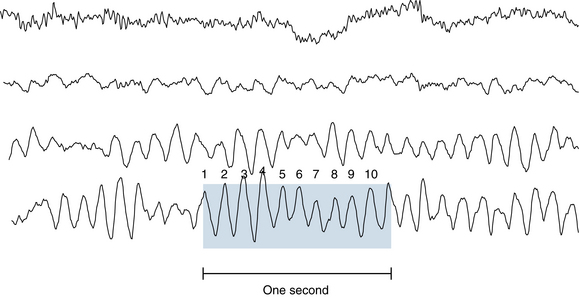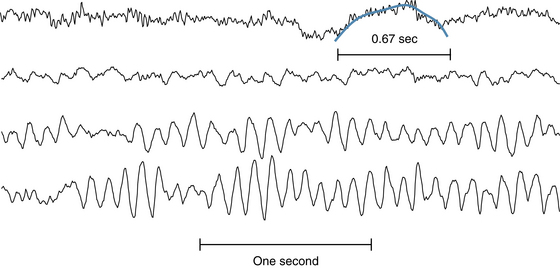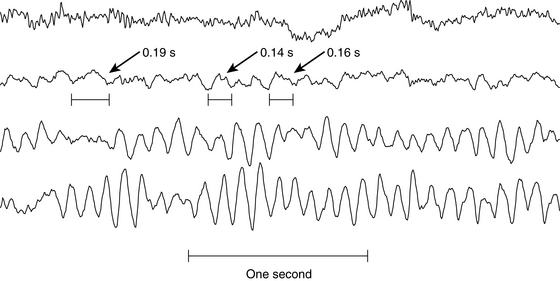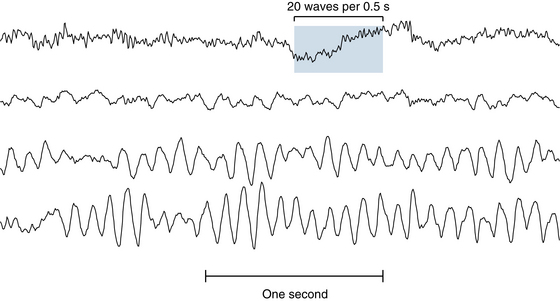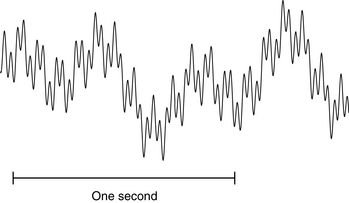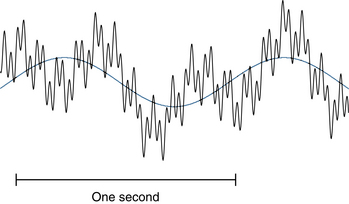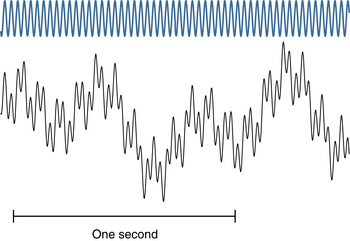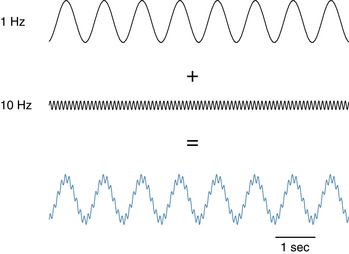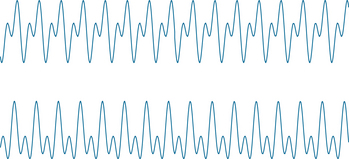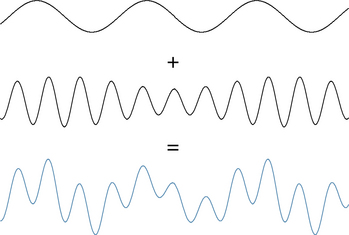Chapter 3 Introduction to Commonly Used Terms in Electroencephalography
In this chapter, we review the basic terms used in electroencephalography and strategies for communicating EEG findings to others. The creation of a concise description of an EEG tracing is a key part of the art and science of EEG interpretation. The ideal EEG description allows its reader, on the basis of the report alone, to visualize the appearance of the EEG even in the absence of the tracing. The report also includes a section that describes the technique used to record the EEG and a separate clinical interpretation of the results that discusses the potential implications that the findings might have for the patient. The specifics of EEG reporting are discussed in more detail in chapter 8, the structure and philosophy of the EEG report.
DESCRIPTION OF EEG WAVES
As mentioned, an ideal description of an EEG waveform would allow the reader to visualize or perhaps even produce an accurate drawing of the wave on the basis of the written description alone. If a wave can be drawn two or more fundamentally different ways from a particular written description, the ambiguity in the description provides a clue as to how it could be improved. In general, a complete description of an EEG wave or event includes the following features: location, voltage (amplitude), shape (morphology), frequency, rhythmicity, continuity, and the amount of the wave seen and in which particular clinical states (awake, asleep) it occurs in the record (Table 3-1). For instance, a left temporal theta wave could be described as follows: “Occasional examples of intermittent, medium voltage, sinusoidal 6–7 Hz waves are seen in the left temporal area during drowsiness.”
Table 3-1 Some Wave Parameters with Specific Descriptive Examples of Each
| Descriptive Parameter | Example |
|---|---|
| frequency | given in cycles per second (cps) or Hertz (Hz) or by frequency range: delta, theta, alpha, or beta |
| location | occipital, frontopolar, generalized, multifocal |
| morphology | spike, sinusoidal waveform |
| rhythmicity | rhythmic delta, irregular theta, semirhythmic slow waves |
| amplitude | high voltage slowing, a 75 μV sharp wave |
| continuity | continuous slowing, intermittent theta, periodic sharp wave |
FREQUENCY
Frequencies are quoted either in cycles per second (cps) or in Hertz (Hz). The terms cps and Hz are synonymous. For historical reasons, each frequency band in the EEG is named using one of four Greek letters. By convention, the names of the letters are written out: delta, theta, alpha, and beta; the symbols for these Greek letters are not used. The terms delta, theta, alpha, and beta are used as a shorthand to refer to rhythms in specific frequency bands and are defined as follows:
| delta | 0 to <4 Hz |
| theta | 4 to <8 Hz |
| alpha | 8 to 13 Hz |
| beta | >13 Hz |
Very Fast and Very Slow Activity
Although the list above implies that beta-range frequencies are unbounded on the high side, in reality EEG activity recorded at the scalp with routine EEG instruments rarely exceeds 30 to 40 Hz, and even signals from cortically implanted electrodes rarely exceed 50 Hz. High-frequency filtering techniques and other inherent equipment limitations make it difficult to see faster frequencies in routine recordings, even should they be there to record. The assumption behind using high filters is that little or no cerebral activity exceeds 30 to 40 Hz so that any signals above this range likely represent electrical noise or “artifact” from muscle, electrical interference, or other sources—hence, the strategy to filter out most activity above this range. In the early days of EEG, frequencies above 30 Hz were said to be in the gamma range, but the term (and the concept) was later discouraged. More recently, there has been renewed research interest in “gamma activity,” although such very fast activity has yet to establish its place in the mainstream of conventional EEG interpretation.
Similarly, although the lower bound of the delta frequency range is “zero Hz,” it was initially felt that there was little cerebral activity below 0.5 Hz. Newer techniques have successfully recorded very slow activity, which are termed DC potentials because they resemble shifts of the baseline (direct currents) rather than oscillations. Again, because standard recording techniques usually exclude most such very slow activity, frequencies much below 0.5 Hz are usually not reliably observed in conventional EEG recordings. Despite the possible existence of some very slow potentials in the EEG, in some situations, the great majority of activity below 0.5 Hz usually represents motion or electrical artifact rather than electrocerebral activity. Conventional filtering techniques attempt to remove these large baseline shifts from the recording because they usually represent artifact and may render the EEG tracing unreadable (see Chapter 7, Filters).
A Note on Units
The foregoing examples assume that wavelengths are stated in seconds, but it is common practice to quote wave durations in milliseconds (msec). Rather than stating that a wave lasts 0.2 seconds, it is often said that the wavelength is 200 msec. Using milliseconds is perfectly satisfactory, except when it comes to using the formula cited earlier to calculate frequency. The reciprocal of 200 is 0.005, which clearly is not the correct frequency of a wave of 200 msec duration. This is because inserting a wavelength in milliseconds into the formula yields the result in the undesirable unit of “cycles per millisecond.” To yield the frequency in cycles per second, or Hertz, the wavelength used in the formula must always be stated in seconds (1 cycle/0.2 sec = 5 cps). Examples of how the frequency of alpha, delta, theta, and beta activity are assessed are shown in Figures 3-1 through 3-4.
Waves of Mixed Frequency and the Fourier Theorem
One important skill in EEG interpretation is the ability to “deconstruct” EEG waves visually into their component frequencies. The idea that a repetitive complex wave can always be broken down into simpler, fundamental waves was proved by Joseph Fourier in a mathematical theorem called the Fourier theorem. This theorem states, in simplified terms, that any waveform, no matter how simple or complex, can be exactly described by the sum of a sufficient number of simple sine waves. Although a comprehensive discussion of the Fourier theorem is beyond the scope of this text and not necessary to EEG interpretation, it reminds us that even the most complex EEG waves may be thought of as the sum of some number of fundamental sine waves. For example, the apparent complex wave shown in Figure 3-5 actually represents the combination of a 1-Hz wave, a 2.4-Hz wave, an 11.7-Hz wave, and a 34-Hz wave, each of a different amplitude. It is not necessarily the electroencephalographer’s goal to identify all of the component parts of any particular EEG wave, but it is useful to be able to identify the fundamental wave and the main superimposed waves of an EEG signal. Figures 3-6 through 3-9 illustrate the component waves that make up the complex wave of this example.
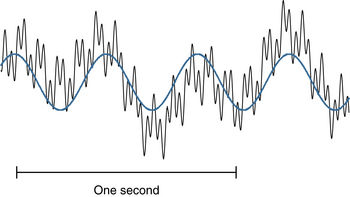
Figure 3-7 The same wave as Figure 3-6 with the 2.4-Hz component isolated and superimposed. Of all the component waves (with the possible exception of the fastest 34-Hz wave), this 2.4-Hz component frequency can be most easily identified in the mixed wave. Along with the 1-Hz wave, the 2.4-Hz wave lends some of the “roller-coaster” shape to the final wave.
Figure 3-10 shows the result of superimposing or adding a lower voltage 10-Hz wave onto a higher voltage 1-Hz wave. Note that the lower voltage fast activity appears to “ride” the hills and valleys of the slower wave. The key is that both individual waves can still be visually appreciated even though they are mixed together.
Figure 3-11 shows an example of adding a 2-Hz wave to its 4-Hz harmonic. Note how the shoulder of the slower wave is regularly notched by the faster wave in this idealized example. The notching may appear on the upslope, downslope, peak, or trough of the slower wave, depending on how the phase of one wave is lined up with the phase of the other when the two are added together. This pattern is important to recognize because the notching patterns created by these harmonics can occasionally be mistaken for spike-wave discharges.
Figure 3-12 shows how the appearance of the superimposition of the same 2-Hz and 4-Hz waveforms can differ depending on how the phase of one is shifted to the right or left in comparison to the other.
Figure 3-13 shows the result of adding a fundamental 2-Hz wave (top trace) to a 7-Hz wave of slightly varying amplitude (middle trace). In reality, the important skill is not necessarily to be able to predict what the result will be of adding two particular waves together but, rather, the reverse procedure: to be able to look at the bottom trace in Figure 3-13 and to be able to visually reconstruct the distinct 2-Hz and 7-Hz rhythms contained within the more complex waveform. Although the examples shown in these figures are of idealized sine waves, the same visual skills apply to the “deconstruction” of actual EEG waveforms. Of course, the idealized waves seen in these examples do not occur in such pure forms in complex biological systems such as the brain, which are more complex and subject to more variation.
Figures 3-14 and 3-15 show examples of other ways that pure sine waves can vary, such as in frequency and amplitude, and represent somewhat more realistic approximations of real-life EEG waves.
Figure 3-16 shows a close-up of a recorded EEG wave that contains mixed frequencies.
Stay updated, free articles. Join our Telegram channel

Full access? Get Clinical Tree




